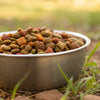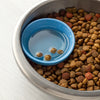How Many Grams of Dry Dog Food Per Day? A Comprehensive Feeding Guide for Pet Owners
- Houndsy
Table of Contents
- Introduction
- Understanding Dog Nutrition
- Calculating Daily Food Intake
- Monitoring Your Dog’s Body Condition
- The Importance of Quality Dog Food
- Feeding Frequency
- Utilizing the Houndsy Kibble Dispenser
- Frequently Asked Questions (FAQ)
Introduction
Did you know that approximately 59% of dogs in the United States are considered overweight or obese? This startling statistic highlights a critical issue that many pet owners face: determining the right amount of food to keep our furry friends healthy and happy. As responsible dog owners, we all want to ensure our pets receive the right nutrition, but with so many factors influencing how much food our dogs need, it can be quite confusing.
In this blog post, we will delve deep into the question of how many grams of dry dog food per day is appropriate for your pet. We will explore the various factors that affect your dog's dietary needs, including age, size, activity level, and health status. By the end of this guide, you will have a clear understanding of how to tailor your dog’s diet to ensure they receive the optimal amount of nutrients without the risk of overfeeding or underfeeding.
We invite you to reflect on your own pet feeding routines as we navigate through the essentials of canine nutrition. Our mission at Houndsy is to simplify your dog feeding experience with our innovative products like the Houndsy Kibble Dispenser, designed to enhance convenience and style in your pet care routine. Let’s embark on this journey to better pet health together!
Understanding Dog Nutrition
The Importance of Proper Nutrition
Proper nutrition is vital for your dog's overall health and well-being. Just like humans, dogs require a balanced diet that includes carbohydrates, proteins, fats, vitamins, and minerals. Feeding your dog the right amount of food is crucial to avoid health issues such as obesity, malnutrition, and related complications.
Nutritional Requirements by Life Stage
- Puppies: Growing puppies have different nutritional needs compared to adult dogs. They require higher levels of protein and calories to support their rapid growth and development. Typically, puppies should be fed multiple small meals throughout the day.
- Adult Dogs: Adult dogs need a balanced diet that maintains their weight and energy levels. The amount of food required can vary significantly based on their size and activity level.
- Senior Dogs: As dogs age, their metabolism slows down, and they may require fewer calories. Senior diets often include ingredients that support joint health and cognitive function.
Key Factors Influencing Food Quantity
When determining how many grams of dry dog food to feed your dog daily, several factors come into play:
- Weight: The dog's ideal weight is often used to calculate their food intake. For instance, feeding guidelines typically suggest around 10 grams of dry food per kilogram of body weight.
- Activity Level: Active dogs tend to require more calories compared to those that lead a more sedentary lifestyle. If your dog is constantly on the move, they may need additional food to meet their energy demands.
- Health Status: Dogs with specific health conditions might need specialized diets. Always consult your veterinarian if your dog has health concerns that may affect their feeding needs.
- Age: Puppies and adult dogs have different caloric needs. Puppies often need more food than adults of the same weight due to their growth requirements.
Calculating Daily Food Intake
Feeding Guidelines from Dog Food Manufacturers
Most commercial dog foods provide feeding guidelines on their packaging. These guidelines are typically based on the dog's weight and can be a helpful starting point. For example, a common guideline might suggest feeding:
- Small dogs (up to 10 kg): 50-190 grams per day
- Medium dogs (10-25 kg): 155-340 grams per day
- Large dogs (over 25 kg): 345-1030 grams per day
However, these are general recommendations and should be adjusted based on the factors discussed earlier.
The Role of Activity Level
To give you a clearer picture, here’s a detailed breakdown of how much to feed your dog based on activity level:
- Low activity: Dogs that are less active may need about 20% fewer calories than the standard feeding guidelines.
- Moderate activity: Dogs that engage in regular but not intense exercise should follow the standard feeding guidelines.
- High activity: Active dogs, such as working or sporting breeds, may require up to 50% more food than the standard recommendation.
Example Calculation
To illustrate how to calculate your dog's daily food intake, let's consider a hypothetical scenario:
- Dog's Ideal Weight: 20 kg
- Standard Feeding Guideline: 300 grams of dry food per day for a 20 kg dog.
- Activity Level: Moderate activity level.
In this case, you would follow the 300 grams guideline, but if your dog were highly active, you might increase it to around 450 grams per day.
Monitoring Your Dog’s Body Condition
Body Condition Scoring (BCS)
To ensure your dog is at a healthy weight, you can use a Body Condition Score (BCS) system. This involves assessing your dog's body shape and fat coverage. The BCS will help you determine whether to adjust their food intake:
- Underweight (1-3/9): Dogs that score low may require 10-20% more food.
- Ideal Weight (4-5/9): Continue feeding the recommended amount.
- Overweight (6-9/9): Dogs that are overweight may need 10-20% less food.
Regular Weigh-Ins
Regular weigh-ins at the vet or using a home scale can help you keep track of your dog's weight and make necessary adjustments to their diet.
The Importance of Quality Dog Food
Choosing High-Quality Food
Not all dog foods are created equal. The quality of the ingredients impacts how much food you should feed your dog. High-quality, nutrient-dense foods often allow for smaller portions while still meeting your dog’s nutritional needs. Look for foods that contain whole ingredients and avoid fillers, by-products, and artificial additives.
Transitioning Dog Foods
If you decide to change your dog’s food, do so gradually over a week to avoid gastrointestinal upset. Mix the new food with the old food, slowly increasing the proportion of the new food each day.
Feeding Frequency
How Many Times a Day Should You Feed Your Dog?
Feeding frequency can vary based on your dog’s age and health:
- Puppies: 3-4 times a day until 6 months old
- Adult Dogs: Typically twice a day
- Senior Dogs: Can remain on the adult feeding schedule or switch to smaller, more frequent meals
Factors to Consider
Consider your dog's lifestyle and your schedule when establishing a feeding routine. Some dogs may do well with one large meal, while others benefit from multiple smaller meals throughout the day.
Utilizing the Houndsy Kibble Dispenser
To simplify the feeding process, we designed the Houndsy Kibble Dispenser. This innovative product allows for precise portion control and reduces mess, ensuring you can easily feed your dog the right amount every time. The dispenser holds a large capacity of up to 30 lbs of kibble, making it convenient for both you and your pet. Plus, its sleek mid-century modern design enhances your home decor while keeping your feeding area tidy.
Explore our Houndsy Kibble Dispenser to elevate your dog feeding experience today!
Frequently Asked Questions (FAQ)
1. How do I know how much dry dog food to feed my dog?
Start with the feeding guidelines on the dog food packaging, then adjust based on your dog’s weight, activity level, and health status. Regular weigh-ins and observing your dog’s body condition will help you fine-tune their food intake.
2. Can I mix wet and dry dog food?
Yes, you can mix wet and dry dog food. Make sure to adjust the quantities so that the total daily intake remains within the recommended limits. A common approach is to split the total recommended amount between the two types of food.
3. What should I do if my dog is overweight?
If your dog is overweight, consult your veterinarian for a weight management plan. You may need to reduce their food intake, switch to a lower-calorie diet, and increase their exercise.
4. How often should I feed my puppy?
Puppies should be fed 3-4 times a day until they are about six months old. After that, you can transition to two meals a day.
5. Is it safe to free-feed my dog?
Free-feeding, or leaving food out for your dog to eat at their leisure, can lead to overeating and obesity. It’s generally better to establish a set feeding schedule to monitor their intake.
In conclusion, determining how many grams of dry dog food per day your dog should consume involves understanding their unique needs and adjusting accordingly. With the right approach, you can ensure your furry friend stays healthy and happy for years to come. Remember, at Houndsy, we’re here to support you in simplifying and enhancing the feeding experience for you and your beloved pets.












